Kristine Hughes's Blog, page 56
August 19, 2016
A TOUR GUIDE IN ENGLAND: DAY 3 - PART 5

If you'll recall, the last post in this series ended with Diane and I finally making it through Trafalgar Square in a cab on our way to the theatre district.

Leaving the cab in Charing Cross Road, we cut through Cecil Court to St. Martin's Lane

and we came out at the London Coliseum, where we had tickets to see Glenn Close in Sunset Boulevard, the musical.



I knew that this limited run of Andrew Lloyd Webber's musical was a reprisal of the role Glenn Close had played to acclaim on Broadway in 1994. Still, as we waited for the curtain to go up, I couldn't help but to think `this is either going to be really good or really bad.` I love the original black and white film of Sunset Boulevard starring Gloria Swanson and William Holden. I couldn't imagine that it could be done any better. And a muscial in the bargain?
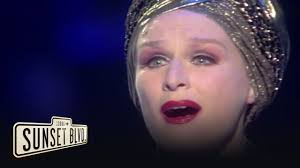
Reader, it was really good. No, it was fabulous. Glenn Close was Norma Desmond. Don't take my word for it - watch her performance here.

After standing through several curtain calls, Diane and I left the theatre and walked up the street for an Italian dinner at Giovanni's, located in Goodwin's Court which, as we left the restaurant after a delicious meal, proved tres atmospheric at night.

And so back to the hotel and bed. Diane and I were exhausted, as it had been a long day. In fact, it had turned out to be a Five Part day. Can you imagine?

Day Four Coming Soon!
Published on August 19, 2016 23:00
August 16, 2016
ONCE AGAIN WEDNESDAY: Mary Anne Clark by Jo Manning - Part Three
The Duke of York set Mary Anne up in lavish accommodations in a mini-palace at 18 Gloucester Place, and by 1805, as his official mistress, she was entertaining, as one source put it, “sumptuously”. She was said to have had twenty servants, which included a housekeeper, five/six maids, two butlers, six or more other male servants (probably footmen and coachmen), and three/four chefs. She had two coaches and at least ten horses. There was also “an elegant mansion at Weybridge” for her sole use.
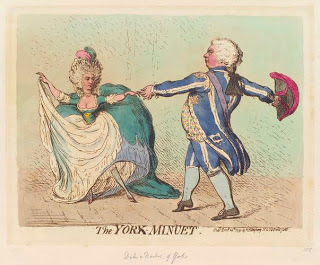
'The York-minuet' (Frederica Charlotte Ulrica Catherina, Duchess of York; Frederick, Duke of York and Albany) by James Gillray (1791)
The prince was married. He was the first of King George II’s children to get married. He’d wed his cousin, Princess Frederica of Prussia, a woman noted for her extremely tiny feet, in 1791. Frederica was petite, very short, not at all attractive, and said to have bad teeth. The duke was no prize himself, described as “a giant of a man…with [a] great bluff red face…bulging eyes…ponderous belly [and a] prominent nose.” Even more detailed is this from another source: “a red, blotched face…a great paunch…a purple, bulbous nose”.
Though Frederica, known as Freddie, was lively, praised for her “neatness”, and considered to be a sensible woman, the couple did not mesh and the marriage was not a success. They lived apart, she at Oatlands Park in Surrey, with eighteen dogs; she had many friends, among them the famous Beau Brummell. (Romance novelist Rosemary Stevens, a few years back, played with Freddie and the Beau’s relationship in a series of mysteries with Brummell as a kind of Regency Sherlock Holmes. Check them out, they’re fun to read!)
At Gloucester Place, Mary Anne Clarke was said to have eaten off exquisite china plates that once belonged to the family of the Duc de Bern, and to drink from crystal wine glasses that had cost upwards of “two guineas a-piece.” (A guinea is a pound plus a shilling.) How much did all this cost to maintain? Mary Anne was never one to stay within a budget, as her past so well illustrates. Her talent – or one of them, at any rate – lay in extravagance.
According to Mary Anne, she received from £1,000 to £1,200 annually from the Duke of York, in monthly allotments, for the maintenance of this enormous household. (Bear in mind that, at that time, one pound was worth seventy to eighty times what it is worth today.) This is at odds with the statement of the Chancellor of the Exchequer at the 1809 trial that she was actually paid £6,000 yearly. Mary Anne countered that her payments from the Duke were irregularly doled out. (It is interesting to note here that the royal brothers received many complaints from their ladybirds over the years that payments were not always forthcoming; this has been documented by the experiences of Mary Robinson and Grace Dalrymple Elliott, among others.)
So, to supplement her income, the avaricious, luxury-loving Mary Anne Clarke hit upon a scheme. She would take the lists of army men up for promotions that were sent to her lover and add the names of soldiers who would pay her for the surreptitious promotions. Only a few each time, added at the very end of the lists to which she was privy, thanks to Frederick -- who carelessly kept them lying around -- so as not to arouse suspicion. But she got much too greedy…and she was caught. By 1809, the jig was up.
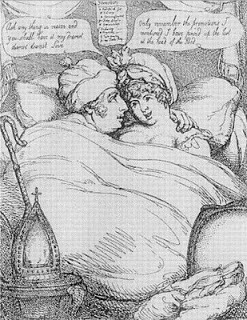
The Bishop And His Clarke Or A Peep Into Paradise… The Duke of York, Commander-in-Chief of the army (and titular Bishop of Osnabruck, as per this reference) being solicited by Mary Anne Clarke to obtain promotions for her paying clients and friends. The caricature is by Rowlandson, printed by Tegg, 1809.
In January 1809, a little-known Welsh MP, Colonel Gwyllym Lloyd Wardle, alleged in the House of Commons that Frederick, as Duke of York -- the “spare” after his brother the heir to the throne -- and Commander-in-Chief of the Army, “had sanctioned, facilitated, and personally profited from the illicit trafficking in army commissions that his former mistress, Mary Anne Clarke, had engaged in while under his ‘protection’.” (The Duke of York Affair, Philip Harling, The Historical Journal, 39, 4 (1996), page 963.)
Captain Gronow, in his gossipy memoirs, states that Wardle got wind of Mary Anne’s dealings owing to becoming “intimately acquainted with her… [and was] so great a personal favourite that …he wormed out all her secret history, of which he availed himself to obtain a fleeting popularity.” Interesting, but, as with anything Gronow says, one has to have the salt shaker handy.
The modern Circe or a sequel to the petticoat", caricature of Mary Anne Clarke by Isaac Cruikshank, 15 March 1809. Her lover Frederick, Duke of York resigned from his post at the head of the British Army ten days after the caricature's publication.
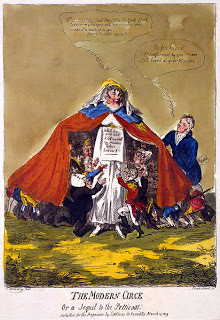
Nevertheless, the charge was sensational, leading to not one but three trials from 1809 to 1813. The first one was the major trial; the subsequent ones were libel suits brought against Mary Anne Clarke and some pamphleteers. Eight specific – and serious -- cases of selling commissions were brought out in the 1809 trial, and are examined minutely in the AAIM, for those who want the sordid (and fascinating) details, but, briefly, it came down to Mary Anne Clarke letting it be known that she would use her influence over the duke to secure commissions and preferments, whether deserved by the petitioners or not, and if this was done with the full knowledge and/or encouragement of the Duke of York. The prices for her intervention into this Army business ranged from £2,600 for promotion to Major to £400 for a mere Ensign. (In the drawing above of the Bishop and his Clarke, the army lists are shown pinned to the almost-conjugal bed shared by Frederick and Mary Anne.) The caricaturists had a field day!
As noted in the caption above, Prince Frederick was forced to resign as Commander-in-Chief of the Army owing to the scandal, but he was reinstated shortly after he was found to be innocent of all the charges brought against him. Another widely circulated caricature was this, attributed to C. Williams and showing Mary Anne with the infamous promotion list in her hand standing before the “York Commission Warehouse”:
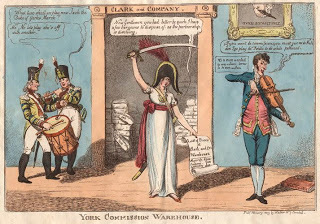
Colored etching, published 1809, shortly after Colonel Wardle had exposed the army commissions scandal in the House of Commons, this satire shows Mrs Clarke with a price list for the sale of commissions. On the right is her intermediary, Domenico Corri, a music master; above him hangs upside down the Duke of York's portrait. Mary Anne is saying that she has bargains for sale but they have to be taken advantage of now because her partnership is dissolving!
The manner in which Mary Anne carried on at the trial was said to have been a tour de force worthy of any seasoned stage performance; her quick wit parried and thrust all questions sent her way and impressed spectators. But her reputation – such as it was – was forever ruined. The Duke of York was able to come back; she wasn’t. It was not a good thing to be identified from thence forward as a friend of Mary Anne Clarke’s; she became a pariah, shunned by the society she in which she’d once played such a large part.
Gillray got into the act, too:
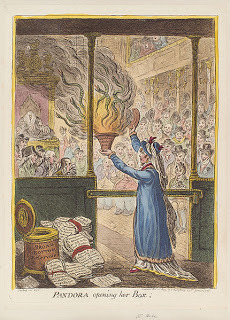
Pandora Opening Her Box, colored aquatint by James Gillray, published by Hannah Humphrey, 1809
After the trial, undaunted, Mary Anne let it be known that she intended to publish Frederick’s love letters. Like his brother George in the case of his mistress Mary Robinson, Frederick had been indiscreet. The boys made too many negative remarks about their family members, the royal family. Sir Herbert Taylor was engaged to enter into negotiations with Mary Anne’s lawyers for the purchase of the letters and the destruction of all other papers still in her hands.
Mary Anne received an enormous annuity – on top of an immediate £7,000 cash settlement -- her son George’s schooling and subsequent Army commission was paid for, and the annuity would pass on to Ellen Clarke, Mary Anne’s daughter, at her death. (Similar to the arrangement with Mary Robinson and the Prince of Wales, but Mary and her daughter got nothing in comparison with the monies paid out to Mary Anne Clarke.)
The terms of the annuity also insisted that Mary Anne quit England and reside on the Continent. She was not to publish anything about the royal family, nor was she to say anything that could be deemed disrespectful about them. Though, much later, she once attempted to break the terms of the arrangement, having been approached by a publisher who promised her many thousands of pounds, her lawyers persuaded her to keep the fat bird in her hand rather than seek ephemeral birds in the bush.
The MP who made the initial allegations against the Duke of York, Colonel Wardle, did bring suit against Mary Anne and two pamphleteers for libel – her name was attached to one of the pamphlets – but they were all acquitted. In 1813, however, Mary Anne again went too far and was once again sued, this time for libel of a powerful politician; she was unable to talk her way out of the predicament – the evidence was too strong against her – and she was convicted, spending nine months in prison, supposedly in solitary confinement.
Part Four Coming Soon!
Originally published on October 26, 2010

'The York-minuet' (Frederica Charlotte Ulrica Catherina, Duchess of York; Frederick, Duke of York and Albany) by James Gillray (1791)
The prince was married. He was the first of King George II’s children to get married. He’d wed his cousin, Princess Frederica of Prussia, a woman noted for her extremely tiny feet, in 1791. Frederica was petite, very short, not at all attractive, and said to have bad teeth. The duke was no prize himself, described as “a giant of a man…with [a] great bluff red face…bulging eyes…ponderous belly [and a] prominent nose.” Even more detailed is this from another source: “a red, blotched face…a great paunch…a purple, bulbous nose”.
Though Frederica, known as Freddie, was lively, praised for her “neatness”, and considered to be a sensible woman, the couple did not mesh and the marriage was not a success. They lived apart, she at Oatlands Park in Surrey, with eighteen dogs; she had many friends, among them the famous Beau Brummell. (Romance novelist Rosemary Stevens, a few years back, played with Freddie and the Beau’s relationship in a series of mysteries with Brummell as a kind of Regency Sherlock Holmes. Check them out, they’re fun to read!)
At Gloucester Place, Mary Anne Clarke was said to have eaten off exquisite china plates that once belonged to the family of the Duc de Bern, and to drink from crystal wine glasses that had cost upwards of “two guineas a-piece.” (A guinea is a pound plus a shilling.) How much did all this cost to maintain? Mary Anne was never one to stay within a budget, as her past so well illustrates. Her talent – or one of them, at any rate – lay in extravagance.
According to Mary Anne, she received from £1,000 to £1,200 annually from the Duke of York, in monthly allotments, for the maintenance of this enormous household. (Bear in mind that, at that time, one pound was worth seventy to eighty times what it is worth today.) This is at odds with the statement of the Chancellor of the Exchequer at the 1809 trial that she was actually paid £6,000 yearly. Mary Anne countered that her payments from the Duke were irregularly doled out. (It is interesting to note here that the royal brothers received many complaints from their ladybirds over the years that payments were not always forthcoming; this has been documented by the experiences of Mary Robinson and Grace Dalrymple Elliott, among others.)
So, to supplement her income, the avaricious, luxury-loving Mary Anne Clarke hit upon a scheme. She would take the lists of army men up for promotions that were sent to her lover and add the names of soldiers who would pay her for the surreptitious promotions. Only a few each time, added at the very end of the lists to which she was privy, thanks to Frederick -- who carelessly kept them lying around -- so as not to arouse suspicion. But she got much too greedy…and she was caught. By 1809, the jig was up.

The Bishop And His Clarke Or A Peep Into Paradise… The Duke of York, Commander-in-Chief of the army (and titular Bishop of Osnabruck, as per this reference) being solicited by Mary Anne Clarke to obtain promotions for her paying clients and friends. The caricature is by Rowlandson, printed by Tegg, 1809.
In January 1809, a little-known Welsh MP, Colonel Gwyllym Lloyd Wardle, alleged in the House of Commons that Frederick, as Duke of York -- the “spare” after his brother the heir to the throne -- and Commander-in-Chief of the Army, “had sanctioned, facilitated, and personally profited from the illicit trafficking in army commissions that his former mistress, Mary Anne Clarke, had engaged in while under his ‘protection’.” (The Duke of York Affair, Philip Harling, The Historical Journal, 39, 4 (1996), page 963.)
Captain Gronow, in his gossipy memoirs, states that Wardle got wind of Mary Anne’s dealings owing to becoming “intimately acquainted with her… [and was] so great a personal favourite that …he wormed out all her secret history, of which he availed himself to obtain a fleeting popularity.” Interesting, but, as with anything Gronow says, one has to have the salt shaker handy.
The modern Circe or a sequel to the petticoat", caricature of Mary Anne Clarke by Isaac Cruikshank, 15 March 1809. Her lover Frederick, Duke of York resigned from his post at the head of the British Army ten days after the caricature's publication.

Nevertheless, the charge was sensational, leading to not one but three trials from 1809 to 1813. The first one was the major trial; the subsequent ones were libel suits brought against Mary Anne Clarke and some pamphleteers. Eight specific – and serious -- cases of selling commissions were brought out in the 1809 trial, and are examined minutely in the AAIM, for those who want the sordid (and fascinating) details, but, briefly, it came down to Mary Anne Clarke letting it be known that she would use her influence over the duke to secure commissions and preferments, whether deserved by the petitioners or not, and if this was done with the full knowledge and/or encouragement of the Duke of York. The prices for her intervention into this Army business ranged from £2,600 for promotion to Major to £400 for a mere Ensign. (In the drawing above of the Bishop and his Clarke, the army lists are shown pinned to the almost-conjugal bed shared by Frederick and Mary Anne.) The caricaturists had a field day!
As noted in the caption above, Prince Frederick was forced to resign as Commander-in-Chief of the Army owing to the scandal, but he was reinstated shortly after he was found to be innocent of all the charges brought against him. Another widely circulated caricature was this, attributed to C. Williams and showing Mary Anne with the infamous promotion list in her hand standing before the “York Commission Warehouse”:

Colored etching, published 1809, shortly after Colonel Wardle had exposed the army commissions scandal in the House of Commons, this satire shows Mrs Clarke with a price list for the sale of commissions. On the right is her intermediary, Domenico Corri, a music master; above him hangs upside down the Duke of York's portrait. Mary Anne is saying that she has bargains for sale but they have to be taken advantage of now because her partnership is dissolving!
The manner in which Mary Anne carried on at the trial was said to have been a tour de force worthy of any seasoned stage performance; her quick wit parried and thrust all questions sent her way and impressed spectators. But her reputation – such as it was – was forever ruined. The Duke of York was able to come back; she wasn’t. It was not a good thing to be identified from thence forward as a friend of Mary Anne Clarke’s; she became a pariah, shunned by the society she in which she’d once played such a large part.
Gillray got into the act, too:

Pandora Opening Her Box, colored aquatint by James Gillray, published by Hannah Humphrey, 1809
After the trial, undaunted, Mary Anne let it be known that she intended to publish Frederick’s love letters. Like his brother George in the case of his mistress Mary Robinson, Frederick had been indiscreet. The boys made too many negative remarks about their family members, the royal family. Sir Herbert Taylor was engaged to enter into negotiations with Mary Anne’s lawyers for the purchase of the letters and the destruction of all other papers still in her hands.
Mary Anne received an enormous annuity – on top of an immediate £7,000 cash settlement -- her son George’s schooling and subsequent Army commission was paid for, and the annuity would pass on to Ellen Clarke, Mary Anne’s daughter, at her death. (Similar to the arrangement with Mary Robinson and the Prince of Wales, but Mary and her daughter got nothing in comparison with the monies paid out to Mary Anne Clarke.)
The terms of the annuity also insisted that Mary Anne quit England and reside on the Continent. She was not to publish anything about the royal family, nor was she to say anything that could be deemed disrespectful about them. Though, much later, she once attempted to break the terms of the arrangement, having been approached by a publisher who promised her many thousands of pounds, her lawyers persuaded her to keep the fat bird in her hand rather than seek ephemeral birds in the bush.
The MP who made the initial allegations against the Duke of York, Colonel Wardle, did bring suit against Mary Anne and two pamphleteers for libel – her name was attached to one of the pamphlets – but they were all acquitted. In 1813, however, Mary Anne again went too far and was once again sued, this time for libel of a powerful politician; she was unable to talk her way out of the predicament – the evidence was too strong against her – and she was convicted, spending nine months in prison, supposedly in solitary confinement.
Part Four Coming Soon!
Originally published on October 26, 2010
Published on August 16, 2016 23:30
August 12, 2016
A TOUR GUIDE IN ENGLAND: DAY THREE - PART 4

When last we met, I was sitting in the Duke of Wellington Pub (affectionately known as the Duke of Boots) just off of Sloane Square, nursing my rum and coke after the Nigel Havers debacle (Nigel Havers!) Unfortunately, I had to leave the pub sometime, so Diane and I got a cab and prepared to head back across town to the theatre district, as we had tickets for a play this evening.
Once inside the cab, we saw . . . . well, why tell you what we saw when I can show you?


Buckingham Palace, above and below.


Palace above, Victoria Memorial below.




The Mall, above, and the Duke of York column, below.


Driving along the Embankment, above and below.


Heading towards Admiralty Arch with traffic at a crawl, above and below.


Through the Arch. Waiting to enter Trafalgar Square.

Inching towards Trafalgar Square. Lucky if three cars get through on each light change.

Red light again . . . . . Drummonds Bank, below.


Still in Trafalgar Square . . . .

Yup. Still here. Oh, look, a lion!

Still crawling through the Square.


More lions . . . . honestly, we just should have gotten out and walked.

And we're through! Finally. . . . frankly, I'm exhausted just reliving that drive. I'll have to wait till the next installment in order to tell you which play we saw.
I'll give you a hint - Nigel Havers wasn't in it.
Part Five Coming Soon!
Published on August 12, 2016 23:30
August 10, 2016
ONCE AGAIN WEDNESDAY: Mary Anne Clark by Jo Manning - Part Two
Mary Anne Clarke was a beautiful woman. Not all courtesans were beautiful – some relied on wit more than beauty -- but she was amongst the beauties. Her features – the wealth of soft, dark, curly hair, the changeable eyes (probably hazel), tip-tilted nose, red lips, dimpled chin, the superb white neck and shoulders and a full bosom -- were admirably painted in the miniature on ivory by Adam Buck at the beginning of this piece. Her figure was petite, her feet tiny, and her smile (and laugh) as described by her great-great-grand-daughter, above, infectious and memorable. She was also said to be intelligent and quick-witted, known for her skill at repartee and the sharpness of her remarks.
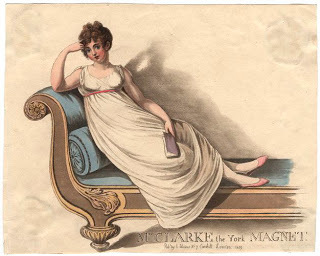
“Mrs Clarke the York Magnet”, hand-colored aquatint by unknown artist, published 1809
But she was a vulgar piece of work, this girl from the mean streets of London, often coarse in language and behavior, impudent, provocative, feisty, tough, possessing a “gutter loveliness,” Du Maurier noted, that was perhaps all “the more alluring because it was ill-bred.” Those not taken in by her smile described her as being “an actress…completely unscrupulous in every way.”
From the 1809 source Authentic And Interesting Memoirs of Mrs Clarke, From Her Infamy To The Present Time, Likewise A Brief Account of Mr Wardle’s Charges Relative To His Royal Highness The Duke of York: Together With The Minutes of Evidence As Taken In The House Of Commons From Authentic Documents… anonymously published in England (and abroad), there is much biographical information…most of it dubious. (I will abbreviate this source as AAIM.) The unverifiable nature of most of this material, however, has not kept it from being repeated as fact in articles relating to the life of Mary Anne Clarke.
From the AAIM, we are told that she was born circa 1776, in an area of London called Ball-and-Pin Alley, near White’s Alley, Chancery Lane (it’s sometimes cited as Bowling Inn Alley or Bowling Pin Alley). It was a humble upbringing, to be sure, a place of ill-kept and dirty lodging-houses, where poverty reigned. Her maiden name is given as Thompson, and we are told that her father was a tradesman who died when she was young. There was a stepfather named Farquhar who’s described as a compositor/corrector at a print-shop owned by a Mr. Hughs in Fleet Street.
The narrative of this so-called memoir relates that Mary Anne would go daily to the print-shop to collect her stepfather’s work, and that she’d undertake the necessary correcting, thus becoming the mainstay of her struggling family. This assumes, of course, that she’d been taught to read and write – and did both well -- before she took this upon herself. The narrative goes on to say that a Mr. Day, the overseer of the print-shop -- attracted by her vivacity and charm, no doubt -- sends her to a school at Ham, in Essex, to be educated. His motive, we are told, is that he had “a view of making her his wife at some future period,” but when she returns, after supposedly spending two years in Ham, things do not work out for Mr. Day. Wedding off! (And, really, it is hard to believe this sending-away-to-school scenario ever happened.)
At this juncture, the Thompson/Farquhar family moves to Black Raven Passage, Cursitor-street, in Holborn, and the narrative goes on to tell of her dealings with a pawnbroker, a Mr F—ll--d, who gives her exorbitant sums of money, to the extent that she eventually ruins him and his business. Undaunted, Mary Anne then sets her sights on another man, Joseph Clarke, the second son of a wealthy bricklayer in Angel-Court, Snowhill, with whom she elopes to Pentonville. She is probably about seventeen years old; they supposedly married in 1794. Clarke’s father sets him up in a business, a stone yard in Golden-lane. (Captain Gronow, in his memoirs, says that Clarke was “a captain in a marching regiment” which has no substantiation whatsoever; Gronow’s memoirs are a wealth of information on the Regency period, but he is often careless with his facts.)
In two years, however, Joseph Clarke is bankrupt and there are tales of philandering (“amours”), and that he is “careless and drunken.” There is no money, but there are, according to the narrative, four children, which is at odds with everything else I have seen that says Mary Anne only had two children, George and Ellen, with Clarke. (A recent article by a writer who was comparing Fergie, the divorced Duchess of York, to Mary Anne Clark – an interesting comparison, but one that can go only so far -- stated there were three children. George and Ellen, however, are the only two names that come up consistently. I’ve never seen a reference to a third or fourth child.)
And – are you ready for this? -- now we have Mary Anne on the stage, supposedly playing a Shakespearian role, Portia (!), in The Merchant Of Venice, at the Haymarket Theatre. That is extremely hard to believe! There are some asides to her as an actress, character-wise, but verifying that she was indeed on stage – and in a leading role, yet -- is problematic. (It should be kept in mind, too, that many streetwalkers and courtesans falsely claimed to be actresses.)
What’s more likely is that she took to the streets after breaking up with Clarke. She had to support her children, after all. Below is a cartoon that speculates on this premise. This contemporary cartoon I saw had what appeared to be penciled in scribbling that might be “M--- A---? Clarke”; it shows an ugly old bawd sending a beautiful young streetwalker (who doesn’t look all that much like Mary Anne), out to work; it is undated but bears the caption, Launching A Frigate.
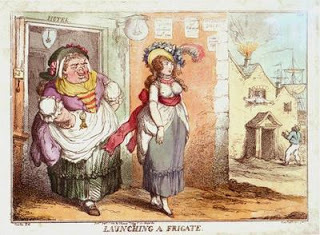 Image is by Rowlandson
Image is by Rowlandson
So, while any career on the streets is difficult to confirm, what is known is that she soon climbed up the well-trodden whore’s ladder and began to consort with eminent and wealthy men. Among the men named in the AAIM narrative are: Sir Charles M—ln—r; Sir James B.; and an army agent, a Mr. O.; a ne’er do well from Bayswater who’d supposedly seen her on stage, Mr. M—l—y; and a high-roller named Mr. Dowler who takes her to Brighton. The dates don’t add up at all, but this bit is priceless:
“At Brighton under the protection of Mr. Dowler, it is said that she distinguished herself as an excellent swimmer, and occasionally to float on the liquid element to the great astonishment and admiration of the spectators.”
The bathing beauty dumps Mr. Dowler – no doubt after bankrupting him, too – and flees to London with Mr. O – now referred to as Mr. O—l—e, the army agent. They set up house in Tavistock Place. Again, the dates don’t make sense, because the attachments mentioned are all up to 1808, and by 1803/4, she’d already met the Duke of York.
The house below is said to be where she was living before meeting Prince Frederick; it is not Tavistock Place. It’s Chester House, formerly called Manchester House, in Exmouth. The lack of verifiable facts abound, as can be seen in the blue plaque put up on the house by the local historical society:
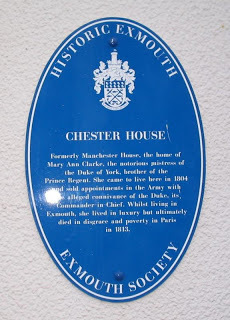
The blue plaque can be seen to the right of the front door. Note that it is not one of the famous – and usually a bit more accurate! -- blue plaques put up by English Heritage. This one states that Mary Anne Clarke “died in disgrace and poverty in Paris in 1813.” Au contraire, as we shall see, for she died in her dotage -- quite well off, despite her many extravagances -- in Boulogne, in 1852 or 1853. (Daphne Du Maurier, despite having cited the use of three researchers, has her death date one way in The Du Mauriers and the other way in Mary Anne. In the recent Christine Hand article contrasting Sarah Ferguson, Duchess of York to Mary Anne, gives the latter’s date of death as 1882, which would have made her 106! She was actually about seventy-six.)
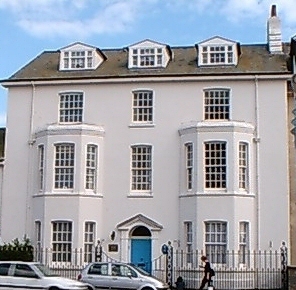
Chester House (Manchester House) with the blue plaque at the side of the front door
So, circa 1803/1804, Mary Anne Clarke, after quite a whirl with quite a large number of men, begins a relationship with Prince Frederick, Duke of York, the brother of Prince George (later King George IV), the Prince of Wales. Frederick was the Commander-in-Chief of the British Army, hence the nursery rhyme of “the grand old Duke of York” (The origins of this ditty actually pre-dated this particular Duke of York, possibly going back to the 14th century, but it has been associated solely with him in recent memory.)
The undated print below shows the two princely sibs with their father, the king.
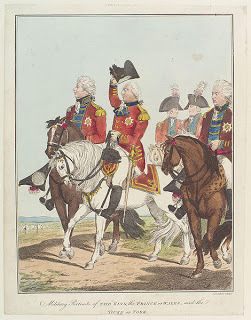
Part Three Coming Soon!
Originally published October 24, 2010

“Mrs Clarke the York Magnet”, hand-colored aquatint by unknown artist, published 1809
But she was a vulgar piece of work, this girl from the mean streets of London, often coarse in language and behavior, impudent, provocative, feisty, tough, possessing a “gutter loveliness,” Du Maurier noted, that was perhaps all “the more alluring because it was ill-bred.” Those not taken in by her smile described her as being “an actress…completely unscrupulous in every way.”
From the 1809 source Authentic And Interesting Memoirs of Mrs Clarke, From Her Infamy To The Present Time, Likewise A Brief Account of Mr Wardle’s Charges Relative To His Royal Highness The Duke of York: Together With The Minutes of Evidence As Taken In The House Of Commons From Authentic Documents… anonymously published in England (and abroad), there is much biographical information…most of it dubious. (I will abbreviate this source as AAIM.) The unverifiable nature of most of this material, however, has not kept it from being repeated as fact in articles relating to the life of Mary Anne Clarke.
From the AAIM, we are told that she was born circa 1776, in an area of London called Ball-and-Pin Alley, near White’s Alley, Chancery Lane (it’s sometimes cited as Bowling Inn Alley or Bowling Pin Alley). It was a humble upbringing, to be sure, a place of ill-kept and dirty lodging-houses, where poverty reigned. Her maiden name is given as Thompson, and we are told that her father was a tradesman who died when she was young. There was a stepfather named Farquhar who’s described as a compositor/corrector at a print-shop owned by a Mr. Hughs in Fleet Street.
The narrative of this so-called memoir relates that Mary Anne would go daily to the print-shop to collect her stepfather’s work, and that she’d undertake the necessary correcting, thus becoming the mainstay of her struggling family. This assumes, of course, that she’d been taught to read and write – and did both well -- before she took this upon herself. The narrative goes on to say that a Mr. Day, the overseer of the print-shop -- attracted by her vivacity and charm, no doubt -- sends her to a school at Ham, in Essex, to be educated. His motive, we are told, is that he had “a view of making her his wife at some future period,” but when she returns, after supposedly spending two years in Ham, things do not work out for Mr. Day. Wedding off! (And, really, it is hard to believe this sending-away-to-school scenario ever happened.)
At this juncture, the Thompson/Farquhar family moves to Black Raven Passage, Cursitor-street, in Holborn, and the narrative goes on to tell of her dealings with a pawnbroker, a Mr F—ll--d, who gives her exorbitant sums of money, to the extent that she eventually ruins him and his business. Undaunted, Mary Anne then sets her sights on another man, Joseph Clarke, the second son of a wealthy bricklayer in Angel-Court, Snowhill, with whom she elopes to Pentonville. She is probably about seventeen years old; they supposedly married in 1794. Clarke’s father sets him up in a business, a stone yard in Golden-lane. (Captain Gronow, in his memoirs, says that Clarke was “a captain in a marching regiment” which has no substantiation whatsoever; Gronow’s memoirs are a wealth of information on the Regency period, but he is often careless with his facts.)
In two years, however, Joseph Clarke is bankrupt and there are tales of philandering (“amours”), and that he is “careless and drunken.” There is no money, but there are, according to the narrative, four children, which is at odds with everything else I have seen that says Mary Anne only had two children, George and Ellen, with Clarke. (A recent article by a writer who was comparing Fergie, the divorced Duchess of York, to Mary Anne Clark – an interesting comparison, but one that can go only so far -- stated there were three children. George and Ellen, however, are the only two names that come up consistently. I’ve never seen a reference to a third or fourth child.)
And – are you ready for this? -- now we have Mary Anne on the stage, supposedly playing a Shakespearian role, Portia (!), in The Merchant Of Venice, at the Haymarket Theatre. That is extremely hard to believe! There are some asides to her as an actress, character-wise, but verifying that she was indeed on stage – and in a leading role, yet -- is problematic. (It should be kept in mind, too, that many streetwalkers and courtesans falsely claimed to be actresses.)
What’s more likely is that she took to the streets after breaking up with Clarke. She had to support her children, after all. Below is a cartoon that speculates on this premise. This contemporary cartoon I saw had what appeared to be penciled in scribbling that might be “M--- A---? Clarke”; it shows an ugly old bawd sending a beautiful young streetwalker (who doesn’t look all that much like Mary Anne), out to work; it is undated but bears the caption, Launching A Frigate.
 Image is by Rowlandson
Image is by RowlandsonSo, while any career on the streets is difficult to confirm, what is known is that she soon climbed up the well-trodden whore’s ladder and began to consort with eminent and wealthy men. Among the men named in the AAIM narrative are: Sir Charles M—ln—r; Sir James B.; and an army agent, a Mr. O.; a ne’er do well from Bayswater who’d supposedly seen her on stage, Mr. M—l—y; and a high-roller named Mr. Dowler who takes her to Brighton. The dates don’t add up at all, but this bit is priceless:
“At Brighton under the protection of Mr. Dowler, it is said that she distinguished herself as an excellent swimmer, and occasionally to float on the liquid element to the great astonishment and admiration of the spectators.”
The bathing beauty dumps Mr. Dowler – no doubt after bankrupting him, too – and flees to London with Mr. O – now referred to as Mr. O—l—e, the army agent. They set up house in Tavistock Place. Again, the dates don’t make sense, because the attachments mentioned are all up to 1808, and by 1803/4, she’d already met the Duke of York.
The house below is said to be where she was living before meeting Prince Frederick; it is not Tavistock Place. It’s Chester House, formerly called Manchester House, in Exmouth. The lack of verifiable facts abound, as can be seen in the blue plaque put up on the house by the local historical society:

The blue plaque can be seen to the right of the front door. Note that it is not one of the famous – and usually a bit more accurate! -- blue plaques put up by English Heritage. This one states that Mary Anne Clarke “died in disgrace and poverty in Paris in 1813.” Au contraire, as we shall see, for she died in her dotage -- quite well off, despite her many extravagances -- in Boulogne, in 1852 or 1853. (Daphne Du Maurier, despite having cited the use of three researchers, has her death date one way in The Du Mauriers and the other way in Mary Anne. In the recent Christine Hand article contrasting Sarah Ferguson, Duchess of York to Mary Anne, gives the latter’s date of death as 1882, which would have made her 106! She was actually about seventy-six.)

Chester House (Manchester House) with the blue plaque at the side of the front door
So, circa 1803/1804, Mary Anne Clarke, after quite a whirl with quite a large number of men, begins a relationship with Prince Frederick, Duke of York, the brother of Prince George (later King George IV), the Prince of Wales. Frederick was the Commander-in-Chief of the British Army, hence the nursery rhyme of “the grand old Duke of York” (The origins of this ditty actually pre-dated this particular Duke of York, possibly going back to the 14th century, but it has been associated solely with him in recent memory.)
The undated print below shows the two princely sibs with their father, the king.

Part Three Coming Soon!
Originally published October 24, 2010
Published on August 10, 2016 00:00
August 5, 2016
A TOUR GUIDE IN ENGLAND: DAY 3 - PART THREE

Through the entrance gates of the Chelsea Physick Garden.

From Wikipedia: The Chelsea Physic Garden was established as the Apothecaries’ Garden in London, England, in 1673. This physic garden is the second oldest botanical garden in Britain, after the University of Oxford Botanic Garden, which was founded in 1621.

The location was chosen as the proximity to the river created a warmer microclimate allowing the survival of many non-native plants – such as the largest outdoor fruiting olive tree in Britain – and more importantly, to allow plants to survive harsh British winters. The river was also important as a transport route that linked the garden to other open spaces such as Putney Heath, facilitating easy movements of both plants and botanists. In fact the garden has always sought to achieve good communications with others working in the same field: by the 1700’s it had initiated an international botanic garden seed exchange system, which continues to this day.





Dr. Hans Sloane, after whom the nearby locations of Sloane Square and Sloane Street were named, purchased the Manor of Chelsea from Charles Cheyne. This purchase of about 4 acres was leased to the Society of Apothecaries for £5 a year in perpetuity.



Environments for supporting different types of plants were built, including the pond rock garden, constructed from a variety of rock types, namely stones from the Tower of London, Icelandic lava (brought to the garden by Sir Joseph Banks in 1772 on a ship named St. Lawrence), fused bricks and flint.


In 1876 the Garden enlarged its educational aspirations by deciding to run a lecture course for young women who were training as botany teachers. At the end of the 19th century the trustees of the City Parochial Foundation agreed to take over the running of the Garden from the Society of Apothecaries. In 1983 The Garden became a registered charity and open to the general public for the first time.

After a spot of lunch at the Gardens, we headed back to Sloane Square.


The day had gone exactly as planned and we had glorious weather throughout.

However, not all things go as planned, as evidenced when actor Nigel Havers walked past me in Sloane Square on his way into a florist shop.
"That's Nigel Havers!" I cried, grabbing Beth's arm.
"Where? Where's Nigel Havers?"
"There! In the florists!"
"Are you sure it's him?"
"It has to be. It looked just like him. Nigel Havers!"
"I'll go and ask him if he is, shall I?"
I looked at her agog. "You're going to speak to Nigel Havers?"
Instead of answering me, Beth strode purposefully towards the shop. Diane and I watched increduously as we heard Beth ask, "Excuse me, but are you Nigel Havers?"
"Only sometimes," Nigel Havers responded.
"It's him! Quick, snap a picture!" I ordered Diane. I was incapable of doing much besides thinking `Nigel Havers!'

Nigel Havers! Chariots of Fire! Downton Abbey! Lots of other notable roles!
"My friend would love to meet you," I heard Beth say to Nigel Havers.
And before I knew it, Nigel Havers was standing beside me.
We shook hands and I heard myself say, "I just watched you in the stately home documentary."
"Oh, yes?" Nigel Havers responded, visibly confused. I couldn't blame him, I was visibly confused. Why had I mentioned the documentary? I had just watched it, it was true, but of all the things to refer to in his entire body of work!
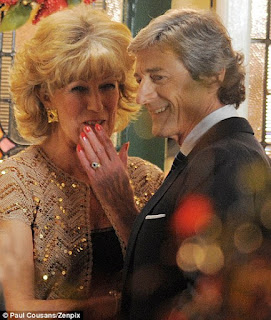
For God's sake, why hadn't I mentioned Coronation Street instead? His character Lewis had won Villain of the Year when he was on the show. I watch Corrie religiously. And I go and mention a country house documentary! Come back, Nigel Havers! Lewis! But Nigel Havers and his recently purchased flowers were already halfway down the sidewalk.
"You met Nigel Havers!" Beth said brightly.
"Yes, and I never even mentioned Coronation Street."
"But you were right, it was Nigel Havers!"
"And it was all down to you, Beth," said Diane. "I can't believe you had the nerve to ask him if he was Nigel Havers."
Beth and Diane turned to me with bright smiles on their faces, "Nigel Havers!" they cried in unison.
"Yes, Nigel bloody Havers. What an idiot I am. Lewis. Coronation Street. For God's sake . . . . oooh, I just saw you in a stupid documentary, Lewis. I'm an idiot, I should have . . . . . . "
I can only conclude by saying that shortly afterwards I found myself in the Duke of Wellington pub, downing a much needed rum and coke, thanks to Diane steering me in the right direction. Honestly, I'm still not over the whole Nigel Havers thing . . . . .
Part Four Coming Soon!
Published on August 05, 2016 23:30
August 2, 2016
ONCE AGAIN WEDNESDAY: Mary Anne Clarke by Jo Manning - Part One
”Mary Anne, Mary Anne,Cook the slut in a frying-pan”
--- Sung in the streets of London following the fall from grace of the courtesan Mary Anne Clarke
***
The Grand old Duke of York he had ten thousand men
He marched them up to the top of the hill
And he marched them down again.
When they were up, they were up
And when they were down, they were down
And when they were only halfway up
They were neither up nor down
--- Old children’s nursery rhyme associated with Prince Frederick, Duke of York, in the early 19th century
***
When I was researching My Lady Scandalous, the biography I was to write of the royal courtesan Grace Dalrymple Elliott, I came across tales of many other royal (and non-royal) courtesans of the era. One of the most colorful and controversial was the mistress of King George III’s brother, Prince Frederick Augustus, the grand old Duke of York. Her name was Mary Anne Clarke.
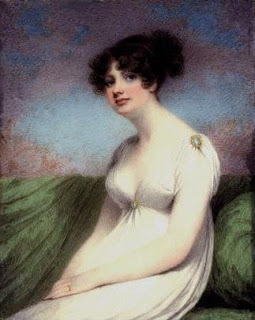 Portrait of Mary Anne Clarke, by Adam Buck, 1803. Though not widely known these days, the Irish-born Buck was an accomplished miniaturist painter and a favorite of the aristocracy. He had a studio in Soho at the time this was painted.
Portrait of Mary Anne Clarke, by Adam Buck, 1803. Though not widely known these days, the Irish-born Buck was an accomplished miniaturist painter and a favorite of the aristocracy. He had a studio in Soho at the time this was painted.What fascinated me was not just that Mary Anne Clarke was involved in one of the major political scandals of the late 18th-early 19th centuries, involving the sale of army commissions for her private gain, but that she was the direct ancestor of the popular novelist Daphne Du Maurier. She was Du Maurier’s great-great-grandmother!
Du Maurier has always been one of my favorite popular writers. The woman was a brilliant storyteller, as evidenced by the remarkable novels Rebecca, My Cousin Rachel, Jamaica Inn, Frenchman’s Creek, and the short stories The Birds and Don’t Look Back.
All of these have been made into excellent, classic films; my particular favorite the most recent retelling of the uber-romantic Frenchman’s Creek, starring Tara Fitzgerald and Anthony Delon. Sorry, I have to digress with this photograph:
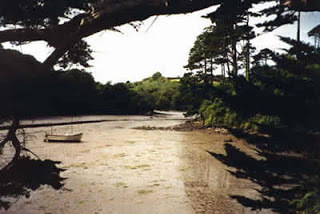
I’ve been here! The Frenchman’s Creek of the book title, on the Helford River, near the town of Helford, Cornwall, at low tide
And who among us can forget the evocative opening line of the suspenseful gothic novel Rebecca: “Last night I dreamed of Manderley again…” as the camera lingers on the ruins of a once-gorgeous mansion shrouded in the flowing mists of sad remembrance and regret. Unforgettable.
But did you know that Daphne Du Maurier also wrote biographies? She wrote a biography of her father, the acclaimed actor-manager Gerald Du Maurier, Gerald: A Portrait, shortly after his death in 1934. Her 1937 family biography, The Du Mauriers, tells the story of a famously talented and eccentric group of actors, novelists, and artists who were descended from Mary Anne Clarke and, on the other side, from the marriage of her daughter Ellen into a family of French émigré glassblowers, the Busson du Mauriers. (She also wrote separately about this French family in The Glass-Blowers, published in 1963.)
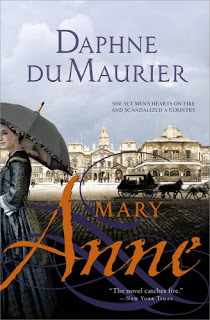
In 1954, the fictionalized biography of Mary Anne Clarke, simply titled Mary Anne, was published. The opening pages of this novel immediately draw the reader into the story. It is good fictional writing at its best. Though the opening below is a long passage, not one word is wasted, and the reader immediately learns all one needs to know about the flamboyant creature Mary Anne Clarke:
“Years later, when she had gone and was no longer part of their lives, the thing they remembered about her was her smile. Coloring and features were indistinct, hazy in memory. The eyes, surely, were blue – but they could have been green or grey. And the hair, knotted in the Grecian fashion piled high on top of the head in curls, might have been chestnut or light brown. The nose was anything but Grecian – that was a certainty, for it pointed to heaven; and the actual shape of the mouth had never seemed important – not at the time, or now.
“The essence of what had been lay in the smile. It began at the left corner of the mouth and hovered momentarily, mocking without discrimination those she loved most – including her own family – and those she despised. And, while they waited uneasily, expexting a blast of sarcasm or the snub direct, the smile spread to the eyes, transfiguring the whole face, lighting it to gaiety. Reprieved, they basked in the warmth and shared the folly, and there was no intellectual pose in the laugh that followed, ribald, riotous, cockney, straight from the belly.“This was what they remembered in after years. The rest was forgotten. Forgotten the lies, the deceit, the sudden bursts of temper. Forgotten the wild extravagance, the absurd generosity, the vitriolic tongue. Only the warmth remained, and the love of living.”
Part Two Coming Soon!
Originally published on October 22, 2010
Published on August 02, 2016 23:30
July 29, 2016
A TOUR GUIDE IN ENGLAND: DAY 3 - PART TWO

Leaving the Royal Chelsea Hospital, Diane Perkins, Beth Elliot, Melanie Hilton and I continued our stroll to the Physick Garden. Here's a bit of what we saw along the way -









What lies beyond those gates?
Part Three Coming Soon!
Published on July 29, 2016 23:30
July 27, 2016
HAPPY 150TH BIRTHDAY TO BEATRIX POTTER
July 28, 2016, is the 150th birthday of Beatrix Potter, an extraordinary woman we remember with great affection and appreciation. Victoria here, a lifelong fan of Peter Rabbit and the other familiar characters she wrote about.

Born in 1866, Helen Beatrix Potter (died 1943) lived in London and vacationed in the Lake District and Scotland. She studied animals and plants, and developed a love of the outdoors as well as an ability to draw plants and fungi.
This website (click here) will give you all the background you need on the stories, her life, and her legacy. It also provides information on the recently discovered Tale of Kitty-in-Boots which will be published in September 2016, a special treat for all of us.,Perhaps Potter's most valuable contribution, beyond her stories, is her gift of more than four thousand acres of land in the Lake District of Britain. She left the land to the National Trust which has maintained her Hill Top Farm (click here) open to visitors. Most of the land is incorporated into the Lake District National Park.
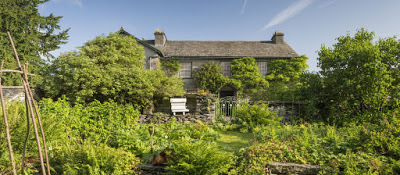 Hill Top Farm
Hill Top Farm
One of my favorite stories is The Tale of Mrs. Tiggy-Winkle. I suspect it is more because I adore hedgehogs, not because I am a neatness freak about housework and laundry.
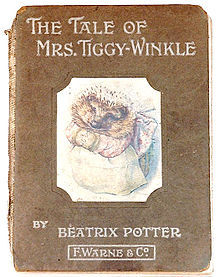
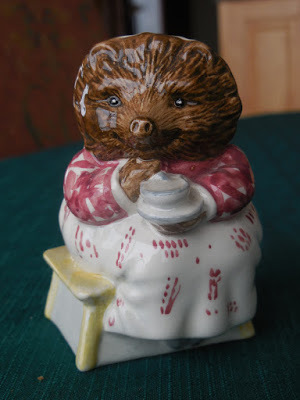 My little statue of Mrs. Tiggy Winkle, from Royal Albert
My little statue of Mrs. Tiggy Winkle, from Royal Albert
Fortunately, Potter's stories and their wonderful illustrations have been preserved. No disney-fication for them! My grandchildren have greatly enjoyed the DVDs from the BBC with the original characters.
In 2006, Miss Potter, starring Renee Zellweger was filmed. The trailer is here. I cannot recall seeing it but I have set about getting a copy for my personal celebration of Miss Potter's 150th!
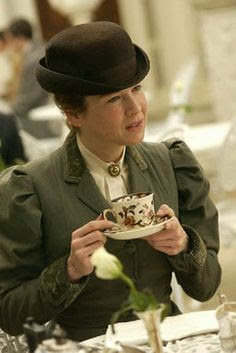 Renee Zellweger as Beatrix Potter
Renee Zellweger as Beatrix Potter
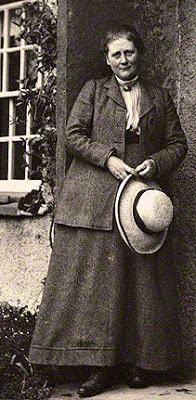 The Real Thing!
The Real Thing!
Hooray for you, Beatrix Potter!! And thank you for all your gifts.

Born in 1866, Helen Beatrix Potter (died 1943) lived in London and vacationed in the Lake District and Scotland. She studied animals and plants, and developed a love of the outdoors as well as an ability to draw plants and fungi.
This website (click here) will give you all the background you need on the stories, her life, and her legacy. It also provides information on the recently discovered Tale of Kitty-in-Boots which will be published in September 2016, a special treat for all of us.,Perhaps Potter's most valuable contribution, beyond her stories, is her gift of more than four thousand acres of land in the Lake District of Britain. She left the land to the National Trust which has maintained her Hill Top Farm (click here) open to visitors. Most of the land is incorporated into the Lake District National Park.
 Hill Top Farm
Hill Top FarmOne of my favorite stories is The Tale of Mrs. Tiggy-Winkle. I suspect it is more because I adore hedgehogs, not because I am a neatness freak about housework and laundry.

 My little statue of Mrs. Tiggy Winkle, from Royal Albert
My little statue of Mrs. Tiggy Winkle, from Royal AlbertFortunately, Potter's stories and their wonderful illustrations have been preserved. No disney-fication for them! My grandchildren have greatly enjoyed the DVDs from the BBC with the original characters.
In 2006, Miss Potter, starring Renee Zellweger was filmed. The trailer is here. I cannot recall seeing it but I have set about getting a copy for my personal celebration of Miss Potter's 150th!
 Renee Zellweger as Beatrix Potter
Renee Zellweger as Beatrix Potter The Real Thing!
The Real Thing!Hooray for you, Beatrix Potter!! And thank you for all your gifts.
Published on July 27, 2016 00:00
July 22, 2016
A TOUR GUIDE IN ENGLAND: DAY 3 - PART ONE
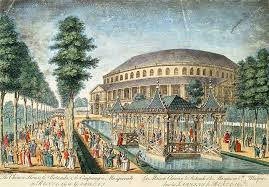
Diane and I began Day 3 with a cab ride to Sloane Square, where we met authors Louise Allen/Melanie Hilton and Beth Elliot for a visit to the Chelsea Physick Gardens. As some of you may know, Beth writes Regency romance and Louise writes Regencies, as well as several non-fiction books, including Walks Through Regency London and To The Field of Waterloo: The First Battlefield Tourists. I had mentioned to Melanie that I wanted to pop in to the Royal Chelsea Hospital in the hopes of visiting the site that once held Ranelagh Gardens, above. Melanie came prepared with research notes and a map and off we set -

The four of us headed out of Sloane Square and down the King's Road.


It was fairly slow going, as we were chatting and stopping to take in architectural details along the way.




Unfortunately, once we'd gotten to the Hospital, we discovered that the Ranelagh Gardens site was inaccessible, as the site was being prepared to host the Royal Chelsea Flower Show, opening in a few days time. Beth, Melanie and I decided instead to visit the Hospital's Museum, while Diane was otherwise occupied, below.


We found this portrait of the Duke of Wellington in the entrance hall, along with French Eagles, such as the one below.



Back outside, we stopped for a photo before heading to the Physick Garden:Left to right: Beth, Melanie and Diane.

Part Two Coming Soon!
Published on July 22, 2016 23:00
July 19, 2016
ONCE AGAIN WEDNESDAY: Prinny's Fete Honoring the Duke of Wellington
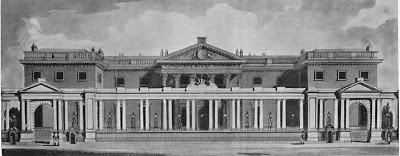
On July 21,1814 the Prince Regent held a Fete in the temporary rooms in the garden of Carlton House to honor the Duke of Wellington. The first of the two thousand guests began to arrive at nine o'clock. They were received at the grand entrance by equerries who conducted the guests to the fanciful rooms and tents on the garden front of Carlton House.
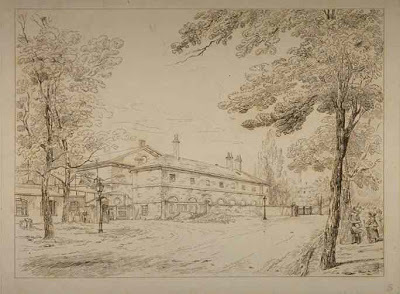 John Nash built a series of temporary rooms and buildings in the garden at Carlton House to house the fete. The illustration at right depicts the side garden in 1820. A polygonal ballroom one hundred and twenty feet in diameter with a tented roof was the main feature. The room was brick with a leaded roof. The interior of the ballroom was designed to give the impression of summer light, airiness, and festivity. It was designed to replicate a huge bell tent so the umbrella shaped ceiling was painted to resemble muslin. The upper walls and ceiling were then hung with gilt cords and tassels to further the resemblance to a tent. Muslin draperies covered the walls. They were swagged open to reveal mirrors hung on the walls. The ballroom was illuminated with twelve sparkling chandeliers. A pair of flower covered temples had been erected in the polygonal ballroom to screen the bands. A covered promenade hung with draperies and rose colored cords led to a Corinthian temple. Inside was a marble bust of the Duke of Wellington by Turnerelli placed on a column in front of a large mirror engraved with a star and a capital letter W. Another covered walkway hung with green calico displayed transparencies representing such subjects as the "Overthrow of Tyranny by the Allied Power". Elsewhere in the garden were supper tents and refreshment rooms hung with white and rose curtains and with regimental colors printed on silk.
John Nash built a series of temporary rooms and buildings in the garden at Carlton House to house the fete. The illustration at right depicts the side garden in 1820. A polygonal ballroom one hundred and twenty feet in diameter with a tented roof was the main feature. The room was brick with a leaded roof. The interior of the ballroom was designed to give the impression of summer light, airiness, and festivity. It was designed to replicate a huge bell tent so the umbrella shaped ceiling was painted to resemble muslin. The upper walls and ceiling were then hung with gilt cords and tassels to further the resemblance to a tent. Muslin draperies covered the walls. They were swagged open to reveal mirrors hung on the walls. The ballroom was illuminated with twelve sparkling chandeliers. A pair of flower covered temples had been erected in the polygonal ballroom to screen the bands. A covered promenade hung with draperies and rose colored cords led to a Corinthian temple. Inside was a marble bust of the Duke of Wellington by Turnerelli placed on a column in front of a large mirror engraved with a star and a capital letter W. Another covered walkway hung with green calico displayed transparencies representing such subjects as the "Overthrow of Tyranny by the Allied Power". Elsewhere in the garden were supper tents and refreshment rooms hung with white and rose curtains and with regimental colors printed on silk. 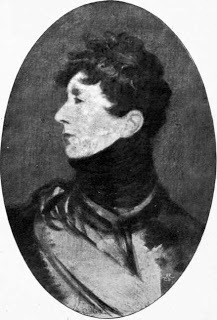
The Regent himself appeared in his field marshal's full dress uniform wearing his English, French, and Prussian orders. He had long wished to be made a field marshal of the British army, but his father had steadfastly refused on the grounds that since George was the Prince of Wales and several of his brothers were pursuing military careers they should hold some honors he did not. Now, as Prince Regent, George could suit himself. The fete was a great success. Even the Queen stayed until half-past four and many guests were still there at dawn.
It's interesting to note that only a few days before the fete, George IV had much more on his mind besides the upcoming festivities - Princess Charlotte and he had come to loggerheads regarding the question of where she was to live. The following account is from George IV: Memoirs of His Life and Reign by Hannibal Evans Lloyd, though this is just one of a hundred accounts of the episode:
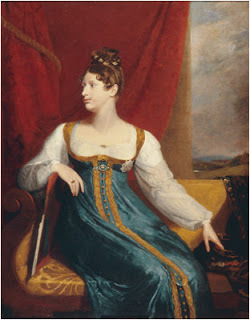 The differences between the Prince Regent and the Princess of Wales caused his Royal Highness some pain on account of the Princess Charlotte, who on several occasions took part with her mother in opposition to his wishes. This led to some very remarkable transactions. Determined that she should be more immediately under his own eye, in the year 1814, on the 12th of July, the Prince Regent visited Warwick House, and informed the Princess Charlotte that he was come to dismiss all her household, and that she must immediately take up her residence in Carlton House, and from thence go to Cranbourn Lodge; and that five ladies, whom he named, amongst whom were the Countess Dowager of Rosslyn, and the Countess of Ilchester, were in the next room in readiness to wait upon her. After some expostulation on the part of the Princess Charlotte, the Prince remaining firm and resolute, she appeared to acquiesce in his determination; but pleading a wish to retire for a moment, to compose herself before she was introduced to the ladies, she was permitted to do so; and whilst the Prince was engaged in close conversation with Miss Knight, a lady of the Princess Charlotte's household, she, in an agony of despair, privately left Warwick House, and throwing herself into a hackney coach, in Cockspur-street, drove to Connaught House, the residence of her mother. Here she found that the Princess of Wales was gone to Blackheath. She despatched a servant to meet her; and threw herself on a bed, exclaiming, "I would rather earn my bread, and live upon five shillings a-week, than live the life I do." Before the Princess of Wales arrived, the Archbishop of Canterbury went to Connaught Place, to fetch the Princess Charlotte away; but Sicard, a faithful servant of the Princess, refused to admit him.
The differences between the Prince Regent and the Princess of Wales caused his Royal Highness some pain on account of the Princess Charlotte, who on several occasions took part with her mother in opposition to his wishes. This led to some very remarkable transactions. Determined that she should be more immediately under his own eye, in the year 1814, on the 12th of July, the Prince Regent visited Warwick House, and informed the Princess Charlotte that he was come to dismiss all her household, and that she must immediately take up her residence in Carlton House, and from thence go to Cranbourn Lodge; and that five ladies, whom he named, amongst whom were the Countess Dowager of Rosslyn, and the Countess of Ilchester, were in the next room in readiness to wait upon her. After some expostulation on the part of the Princess Charlotte, the Prince remaining firm and resolute, she appeared to acquiesce in his determination; but pleading a wish to retire for a moment, to compose herself before she was introduced to the ladies, she was permitted to do so; and whilst the Prince was engaged in close conversation with Miss Knight, a lady of the Princess Charlotte's household, she, in an agony of despair, privately left Warwick House, and throwing herself into a hackney coach, in Cockspur-street, drove to Connaught House, the residence of her mother. Here she found that the Princess of Wales was gone to Blackheath. She despatched a servant to meet her; and threw herself on a bed, exclaiming, "I would rather earn my bread, and live upon five shillings a-week, than live the life I do." Before the Princess of Wales arrived, the Archbishop of Canterbury went to Connaught Place, to fetch the Princess Charlotte away; but Sicard, a faithful servant of the Princess, refused to admit him.As soon as the discovery of the flight of the Princess Charlotte was made known to the Prince Regent, he sent for the ministers, and a council was held at the Foreign Office, and also at Carlton House. The Archbishop of Canterbury not succeeding in the object of his mission to Connaught House, the Duke of York was afterwards sent with a written message from the Prince, containing her father's commands to bring her to Carlton House.
On the arrival of the Princess of Wales from Blackheath, she drove immediately to the Parliament House, and eagerly inquired for Mr. Whitbread, who was absent; she then inquired for Earl Grey, who was not in town; and, disappointed, she hastened to her own house in Connaught-place, and had an affecting interview with her daughter, with whom she continued till three o'clock in the morning. Soon after this time the Princess Charlotte was conveyed, by the Duke of York, to Carlton House; having been previously informed by Mr. Brougham (who had been sent for by the Princess of Wales), that by the laws of the land, she must obey her father's commands. Period.
So, aside from that, Princess Charlotte, how'd you enjoy the fete?
Originally published 7/21/10
Published on July 19, 2016 23:30
Kristine Hughes's Blog
- Kristine Hughes's profile
- 6 followers
Kristine Hughes isn't a Goodreads Author
(yet),
but they
do have a blog,
so here are some recent posts imported from
their feed.



